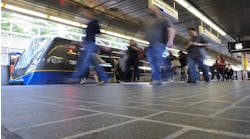The Federal Railroad Administration (FRA) issued two Records of Decision (ROD) for the required National Environmental Policy Act analysis on the Chicago-St. Louis high-speed rail corridor, positioning the project for future federal funding to improve passenger rail speeds, frequencies and reliability.
In its decisions, the FRA selected the Rock Island Corridor as the most efficient route between Joliet and Chicago and chose a consolidated route along 10th Street through Springfield. The decisions will make the corridor eligible for new trains, improved frequencies, help improve on-time performance, and ultimately reduce travel time to less than four hours.
“This represents a major step forward, both for the state of Illinois and the Midwest as a whole,” said U.S. Transportation Secretary Ray LaHood. “Future enhancements to the Midwest Regional Rail Network will create jobs and strengthen the region’s manufacturing base in the future, all while giving travelers a better, faster rail experience.”
“Today’s decisions identify the alignment for the next-generation of Chicago-St. Louis service,” added Federal Railroad Administrator Joseph C. Szabo. “These decisions will allow the project to apply for future federal funding, and is another major win for the Midwest states as they move forward with their vision to connect 40 of their largest cities with fast, frequent and reliable rail service.”
Since 2010, IDOT has received more than $1.4 billion in previously awarded federal funds to develop high-speed rail service between Chicago and St. Louis and build the next generation of American-made trains. Included in these investments are track, equipment, and signaling improvements for 110 mph passenger rail service, as well as station enhancements. A new multi-modal train station in Normal and promise of 110-mph service has attracted more than $200 million in private investments to its downtown area, an example of how rail investment attracts economic growth. Future rail investments along the Chicago to St. Louis corridor will spur additional economic activity across Illinois in towns where new or newly-renovated stations are under development or in the planning stages.
In November, Amtrak reached speeds of 110 mph on the portion of the corridor between Dwight and Pontiac. By 2015, completed construction projects will allow for speeds of 110 mph for over 70 percent of the corridor.

